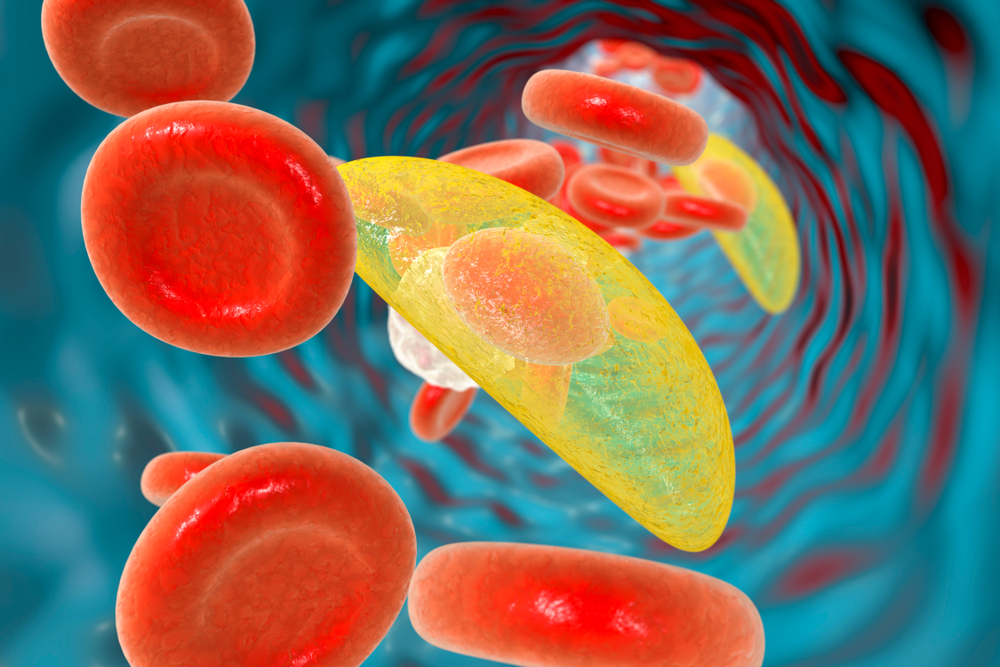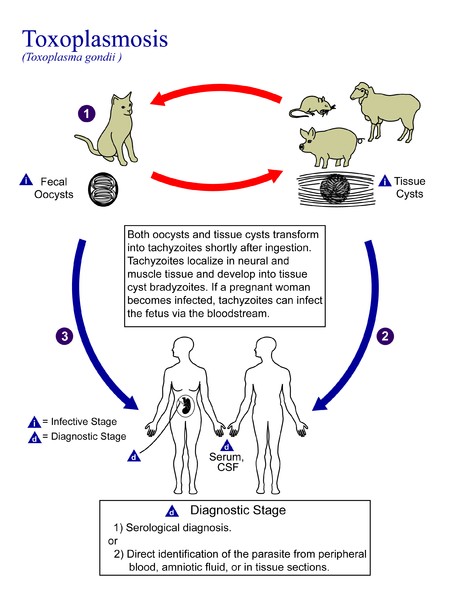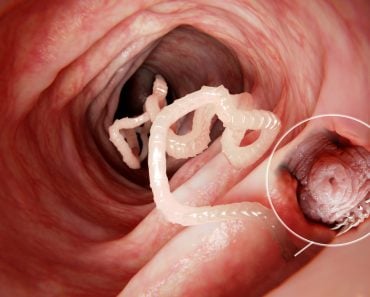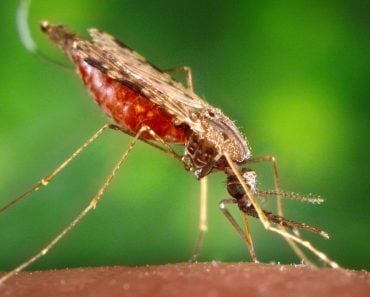Table of Contents (click to expand)
Toxoplasma gondii is a parasite that infects humans and cats. It has been shown to change the behavior of its host, making them more reckless and less scared.
It is estimated that our feline friends were first domesticated sometime around 12000 BCE by Mesopotamian farmers in an effort to control pests. Since then, humans and cats have come to share a long history together. We’ve worshipped them and valued their lives over ours (Persia used cats against Egypt in war, forcing Egypt to surrender, lest they hurt the cats), mummified them, written extensively about them, made them bearers of bad luck and even practitioners of the dark arts.
Today, we consume cat videos and memes by the droves and obsess over whether cat people are better than dog people. Some people love cats so much that we call them ‘Crazy Cat People’.
However, might this close relationship with cats actually have changed us? Do we really become “crazy” because of our cat overlords? The answer to these questions is a unicellular parasitic protozoan – Toxoplasma gondii.

Recommended Video for you:
Toxoplasma gondii‘s Life Cycle
Toxoplasma gondii is a protozoan parasite. Lovingly known as toxo, this parasite is as sneaky as sneaky gets.
It can only sexually reproduce in the intestines of cats, but it cannot mature there. Thus, the baby toxo, also called oocysts, are excreted along with the cat’s feces.
Out there in the open environment, they wait for their ‘intermediate’ host (the animal host in which parasites can mature and multiply). These oocysts are hardy and can survive dormant for up to a year. The intermediate host comes in contact with these baby toxo by eating something that had oocysts in it. The oocysts, once within the host, mature inside the tissue cells of the animal. To complete the toxo’s life cycle, the intermediate hosts is preyed upon and eaten by the cat.
These sorts of life cycles with multiple hosts serving different functions are seen throughout the living world, but toxo has some additional features that put it a cut above the rest.

Toxo Can Infect Many Different Animals
Toxo isn’t playing the same game as most other parasites. Oh no… Toxo has several tools up its sleeve to make sure that it ends up in the right place at precisely the right time.
When tiny baby toxos have been released in the feces of the cat, they lie in wait for their intermediate host. These middlemen are meant to be the common prey of cats, such as rodents and birds.
However, toxo isn’t too finicky when it comes to who it will infect. It infects just about any warm-blooded animal that has been unfortunate enough to have consumed it through contaminated water, dirt or, in the case of humans in particular, through eating meat infected with toxo.

Scientists have observed that some strange things happen when toxo enters and settles into its non-feline hosts.
Imagine that a rat has ingested some oocysts and is now infected. Once within the rat, toxo crosses over from the intestine into the blood, then makes its way to its final maturation ground–the muscle cells and the CNS. Here, within these muscle and neuronal cells, it settles, transforming from an oocyst to a tachyzoite and multiplying.
How Does Toxo Change Its Host’s Behavior?
It seems logical that anything infecting the nervous system is bound to cause some changes in it. Toxo, it seems, deliberately and subtly alters neurons and other nervous cells (astrocytes, microglia) that it infects, which causes the rat (in our case) to perform in some bizarre and ridiculous ways. Scientists have been perplexed by the ingenious behavioral puppetry that toxo performs for its benefit.
The rat seems to react slower to danger, and isn’t as scared of a cat or other new things as it was pre-toxoplasmosis, it develops a strange attraction (or decreased dislike) for cat urine and feces, and it may affect their memory and learning.
These symptoms would make any normal rat worry about their infected compadres. All these uncharacteristic rat behaviors make it easier for the rat to be eaten by a cat. In this round, evolution favored the parasite over the host.
Toxo In Humans
Since toxo was discovered on separate occasions in 1908 by Charles Nicolle and Louis Manceaux in the rodent Ctenodoactylus gundi (hence the name gondii) and Splendor in rabbit tissue, we’ve learnt that toxo can cause serious illness in humans with a compromised immune system.
In the 1930 and 1940s, scientists realized that toxo caused serious abnormalities in a developing fetus. The connection to cats being toxo’s definitive host only came in the 1960s. In individuals with compromised immune systems, like those who have AIDS, toxo can cause blindness and brain lesions and abscesses.
Today, toxo is a pretty common infection–about one-third of the population has it. Toxoplasmosis can be fatal for immune-compromised people, such as those with AIDs, causing brain abscesses and blindness. Toxo can also be harmful to a developing fetus, and may cause developmental abnormalities, so it is recommended that pregnant women avoid cleaning cat litter.
In spite of this being a widespread disease, it has gotten little attention because it remains latent in most humans. Only 10-20% of those with an infection show symptoms (source). For the average Joe, toxoplasmosis can manifest mild flu-like symptoms, but rarely more than that. That being said, what about the non-symptomatic cat person?

Behavioral Changes In Humans Caused By Toxo
Toxo, in spite of remaining latent in humans, has been shown to cause some interesting behavioral changes. Humans have been reported to become more reckless and less fearful. In 2002, a study showed a connection between car accidents and toxo, stating that those infected with toxo were involved in more car accidents than their healthy mobile counterparts
There are also worrying studies implicating repeated toxo infections to an increase in the likelihood of developing psychiatric disorders, such as schizophrenia. Toxo manipulates dopamine levels in the brain, as it has an enzyme that can produce dopamine. Dopamine is a key neurotransmitter in locomotion and fear processing, which partly puts the above findings into perspective.
Since it was discovered in 1908, T. gondii has shown us the manipulative powers that nature holds. This unicellular parasite has managed to infiltrate the land and even the seas (by infecting sea otters). There are many mysteries as to how toxo actually affects its host’s behavior and the repercussions that this can have on humans.
How Does Toxo Affect Cats?
In cats, toxo doesn’t seem to harm the cats all that much. Although rare, cats can also get toxoplasmosis, but once infected, a healthy cat usually develops a life-long immunity against the parasite. Unfortunately, we still know very little about whether toxo affects the behavior of cats at all. Projects like the Toxo Project by the University of Nebraska may help; this is an ongoing survey about how toxo affects home cats and those in the wild.
One thing is certain, your cat will still be the boss of your house, with or without toxo.
References (click to expand)
- Mendez, O. A., & Koshy, A. A. (2017, July 20). Toxoplasma gondii: Entry, association, and physiological influence on the central nervous system. (M.-J. Gubbels, Ed.), PLOS Pathogens. Public Library of Science (PLoS).
- DUBEY, J. P. (2008, November). The History ofToxoplasma gondiiâThe First 100 Years. Journal of Eukaryotic Microbiology. Wiley.
- Flegr, J., Havlícek, J., Kodym, P., Malý, M., & Smahel, Z. (2002, July 2). Increased risk of traffic accidents in subjects with latent toxoplasmosis: a retrospective case-control study. BMC Infectious Diseases. Springer Science and Business Media LLC.
- Cats in the Ancient World - World History Encyclopedia. World History Encyclopedia
- Toxo Project – Cat-behavior Research. toxoproject.com













